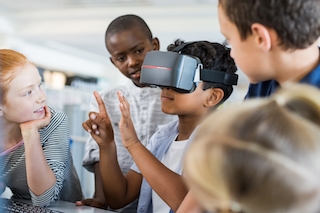 A new study from the University of Waterloo, published in Scientific Reports, aimed to examine the way we learn to perceive the passage of time. Is time perception rigidly fixed in the brain, or is it flexible and open to change? If the latter, how rapidly can our brain adapt to changes in timing statistics?
A new study from the University of Waterloo, published in Scientific Reports, aimed to examine the way we learn to perceive the passage of time. Is time perception rigidly fixed in the brain, or is it flexible and open to change? If the latter, how rapidly can our brain adapt to changes in timing statistics?
“There is a pressing need to improve our understanding of the flexibility of time perception,” study author Michael Barnett-Cowan told us. “Conditions such as schizophrenia, Attention Deficit Hyperactivity Disorder (ADHD), and autism are associated with deficits in perceiving time, and using timing information to support successful behaviour.”
Barnett-Cowan told us that the results of studies like his and his colleagues' will help to improve their understanding about how these deficits are acquired, and if they can be reversed. As well, Barnett-Cowan explained, as virtual reality becomes more widespread in entertainment and industry, we need to understand if interacting with virtual environments can produce perceptual after-effects.
Researchers used virtual reality to expose participants to new types of perceptual feedback, and assessed if their time perception was either compressed or expanded, that is, did events appear shorter or longer in duration to the participant.
"The way we perceive the world is built up through continuous, rich interactions with our environment," Barnett-Cowan told us, "and since our environment is ever-changing, the brain has a flexible capacity for re-learning how to perceive."
According to Fortune, Virtual reality is predicted to generate $150 billion in revenue by the year 2020. By 2025, it's predicted that 500 million virtual reality headsets will be sold. In the U.S., 22.4 million Americans use virtual reality.
The first primitive virtual reality head mounted display created by Morton Heilig, called the 'Telesphere Mask' was showcased in 1960. The term 'virtual reality' was coined in 1987 by Jaron Lanier. Virtual reality uses technology such as googles or headgear to create a simulated environment that stimulates our senses.
Virtual reality products for mass consumption became popular in the 1990s by the companies Sega and Nintendo and was the subject of the cult film, 'The Matrix' in 1999. But as much as virtual reality became a source of entertainment for 'gamers', educational and therapeutic elements also began to emerge from the new and rapidly evolving technology.
Barnett-Cowan and his colleagues predicted that exposing participants to new timing environments in the rich setting of virtual reality would lead to temporal re-calibration effects. To test out their theory, they exposed participants to a dynamic virtual reality game - Robo Recall - during which they coupled their real-world movements to the timing statistics of the virtual reality environment. In short, explained Barnett-Cowan, moving their body caused time to flow normally, while staying still caused time to slow down to a crawl.
After participants played the game for ten minutes, researchers tested their timing abilities using a simple computer task that involved re-producing the movement of a probe on a screen.
“When participants were exposure to the time-flow manipulation in virtual reality, their estimates of the probe duration were around 15% shorter compared to estimates taken before they had completed the virtual reality task,” Barnett-Cowan told us. “This suggests that their perception of time was significantly affected by interacting with the new timing statistics in virtual reality.”
The results confirmed the hypothesis that acting on the world shapes how we perceive time, and that this process is highly flexible.
“We were surprised at the magnitude of the effects, however, given the short period of time for which we exposed participants to the virtual reality manipulation,” Barnett-Cowan told us. “On the other hand, the strong effects show the power of virtual reality for re-calibrating the perceptual systems in natural, realistic settings.”
Barnett-Cowan believes the results bring researchers a step closer to understanding how our actions shape the ways in which we perceive.
“In the short term, our data show that virtual reality is a powerful tool for perceptual re-calibration, which suggests that developers take note of the adaptation effects that could be imparted by virtual reality exposure,” Barnett-Cowan told us. “This is particularly true for the highly-flexible developing brain of adolescents and children, who form a large portion of the virtual reality user-base.”
More work needs to be done to determine the usability of paradigms like the one in the study, Barnett-Cowan explained, for re-calibrating timing in neurological disorders, and to discover how enduring the effects are.
Patricia Tomasi is a mom, maternal mental health advocate, journalist, and speaker. She writes regularly for the Huffington Post Canada, focusing primarily on maternal mental health after suffering from severe postpartum anxiety twice. You can find her Huffington Post biography here. Patricia is also a Patient Expert Advisor for the North American-based, Maternal Mental Health Research Collective and is the founder of the online peer support group - Facebook Postpartum Depression & Anxiety Support Group - with over 1500 members worldwide. Blog: www.patriciatomasiblog.wordpress.com
Email: tomasi.patricia@gmail.com